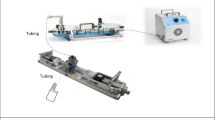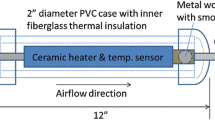Abstract
Objective: To investigate the temperature dependency of the dose released and the plasma levels of nicotine from a vapour inhaler.
Methods: In an open, randomised, three-way cross-over pharmacokinetic study 18 healthy subjects inhaled nicotine for 20 min (80 inhalations) every hour for 10 h (11 administrations) at three different environmental temperatures: 20°, 30° and 40 °C. In the in vitroexperiment, 5, 10, 15 and 20 l air were forced through the inhaler. With a 15 l air volume, the average amount of nicotine released was 1.44, 3.49, 4.80 and 6.99 mg at 10 °C, 22 °C, 29 °C and 40 °C, respectively. The maximum dose released at the highest temperature (40 °C) and the largest air volume investigated (20 l) was approximately 7.5 mg.
Results: In vivo peak plasma levels obtained at 30° and 40 °C were 29.7 and 34.0 ng · ml−1, compared with 22.5 ng · ml−1 at ambient room temperature (20 °C). At 20 °C, the area under the plasma concentration–time curve (AUC) of the last dosing interval was 20.5 ng · ml−1 · h. At 30 °C and 40 °C, the AUCs were 26.5 and 30.3 ng · ml−1 · h, respectively. The results thus showed a mean increase of the in vivo AUC by 29% at 30 °C and by 48% at 40 °C compared with the AUC at 20 °C. These increases should be compared to the in vitro results, showing a mean increase of 59% and 122%, respectively, at 30° and 40 °C. The in vitro results also showed that a relatively larger fraction of the dose was released into the first 5 l of air at the higher temperatures, at 40 °C, about 50% of the total amount released into 20 l.
Conclusion: It was concluded that the in vitro/in vivo discrepancy was most probably due to increased aversive effects at elevated temperatures, causing the subjects to inhale smaller puff volumes. Further, the inhaler would not produce nicotine plasma levels exceeding those achieved following cigarette smoking, even in a hot climate.
Similar content being viewed by others
Author information
Authors and Affiliations
Additional information
Received: 20 September 1996 / Accepted in revised form: 5 March 1997
Rights and permissions
About this article
Cite this article
Lunell, E., Molander, L. & Andersson, SB. Temperature dependency of the release and bioavailability of nicotine from a nicotine vapour inhaler; in vitro/ in vivo correlation. E J Clin Pharmacol 52, 495–500 (1997). https://doi.org/10.1007/s002280050324
Issue Date:
DOI: https://doi.org/10.1007/s002280050324




